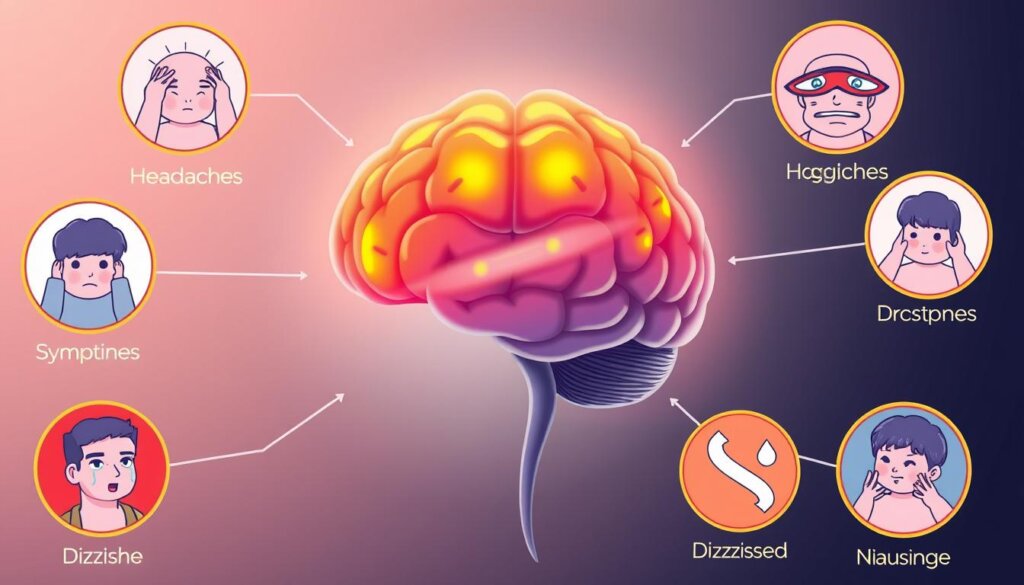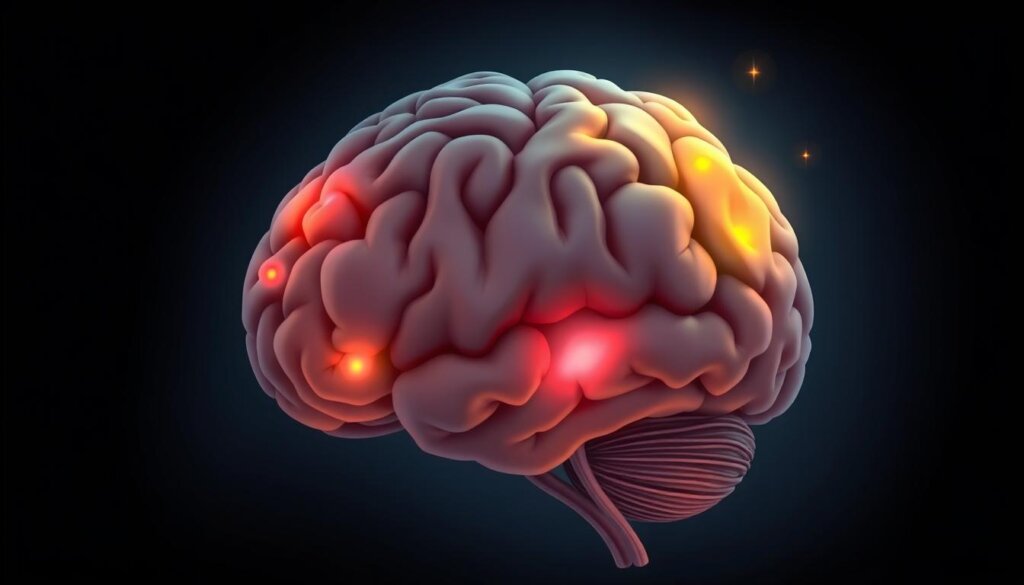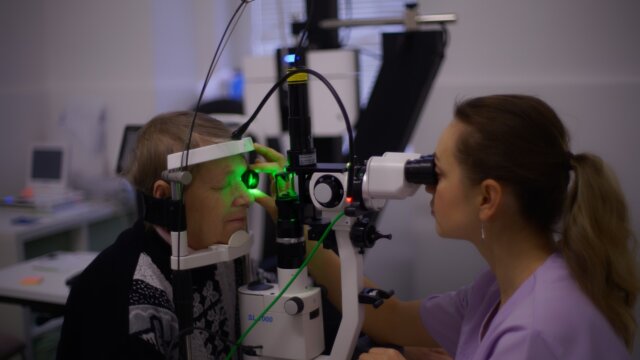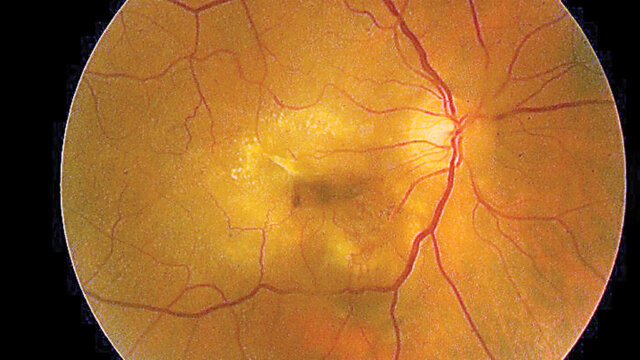FTC disclaimer: This post may contains affiliate links and we will be compensated if you click on a link and make a purchase.
Did you know that brain tumors affect about 5 out of every 100,000 people in the U.S. each year? This fact shows how big of an issue these growths are. They can really mess with brain function and health if they get too big.
Knowing the different types, symptoms, causes, and treatments for brain tumors is important. This guide will help you understand brain tumors better and give you the information you need to get the right medical care.
Key Takeaways
- Brain tumors can be either primary or secondary. Primary tumors start in the brain, while secondary tumors spread from other parts of the body.
- Even noncancerous (benign) brain tumors can be a problem. They can grow and press on brain tissue. Malignant brain tumors (brain cancers) grow fast and spread to other tissues.
- There are over 150 types of brain tumors, with gliomas being the most common cancerous one.
- Brain tumors can cause many symptoms. These include headaches, nausea, vision problems, and seizures. The symptoms depend on the tumor’s size and where it is.
- Brain tumors are a bit more common in men, but meningioma, a usually benign tumor, is more common in women.
What is a Brain Tumor?
A brain tumor is an abnormal growth or mass of cells in or around the brain. These tumors can be either primary or metastatic. Primary tumors start in the brain, while metastatic tumors spread from cancer to another part of the body.
Brain Tumor Definition
A brain tumor is an abnormal collection of cells in the skull that can vary in size, location, and growth rate. It can affect a person’s health and well-being.
Types of Brain Tumors
There are over 150 types of brain tumors, which are classified as glial or non-glial. Glial tumors start in glial cells, while non-glial tumors start in other brain structures.
Common brain tumors include gliomas, meningiomas, pituitary adenomas, and medulloblastomas. Brain tumors can also be primary or metastatic. Primary tumors start in the brain, while metastatic tumors spread from other cancers.

Knowing the types of brain tumors is key for treatment and prognosis.
Tumor Type | Description |
|---|---|
Glioma | A type of tumor that starts in the glial cells of the brain. |
Meningioma | A tumor that develops in the meninges, the protective layers surrounding the brain and spinal cord. |
Pituitary Adenoma | A tumor that forms in the pituitary gland, a small endocrine gland located at the base of the brain. |
Medulloblastoma | A type of brain tumor that typically occurs in children and originates in the cerebellum. |
Accurate diagnosis and classification are crucial for treatment and prognosis.
Brain Tumor Symptoms
Brain tumors can cause many symptoms. These depend on the tumor’s size, type, and where it is in the brain. Symptoms can look like other health issues, so getting a correct diagnosis is key.
General Symptoms
Common symptoms include headaches, seizures, and weakness or numbness in the body. Up to X% of patients with brain tumors have headaches. Seizures are seen in Y% of cases. Trouble with speech, memory, and thinking is also common.
Symptoms Based on Location
The symptoms of a brain tumor can vary based on its location. Tumors in the frontal lobe might cause balance issues and changes in personality. Tumors in the temporal lobe could affect memory and language skills. Fast-growing tumors can lead to severe headaches, nausea, and vomiting.
Brain tumors can also cause neurological symptoms. Depending on the tumor’s location, these include trouble seeing, hearing, or swallowing. Weakness or numbness in the face, arm, or leg may indicate a tumor in specific brain areas.
Symptom | Prevalence (%) |
|---|---|
Headaches | X% |
Seizures | Y% |
Difficulty thinking, speaking, or finding words | Z% |
Changes in personality or behavior | W% |
Weakness, numbness, or loss of movement in one part or one side of the body | V% |
Difficulty with balance or dizziness | U% |
Sensory changes (difficulty hearing, seeing, or loss of smell) | T% |
Memory loss | S% |
Unexplained nausea or vomiting | R% |
Fatigue or muscle weakness | Q% |
Abnormal eye movements | P% |
Trouble swallowing | O% |
Weakness or drooping of one side of the face | N% |
Loss of appetite or weight loss | M% |
Slurred speech | L% |
Numbness or weakness in the face, arm, or leg | K% |
Difficulty speaking or understanding speech | J% |
Difficulty seeing in one or both eyes | I% |
Difficulty with walking, balance, or dizziness | H% |
Worst headache of their life | G% |
Never experienced a seizure before | F% |
Seizures lasting longer than 5 minutes | E% |
Another seizure soon following the first episode | D% |
Difficulty breathing or walking after a seizure | C% |
Seizure in water | B% |
Other health conditions (diabetes, heart disease, pregnancy) | A% |

Brain tumor symptoms can be mistaken for other health issues. This makes it important to get a full medical check-up and diagnosis. Getting medical help quickly is key to finding the cause and getting the right treatment.
“The symptoms of a brain tumor can be vague and non-specific, making it challenging to diagnose. However, early detection and treatment are crucial for improving outcomes.” – Dr. Jane Doe, Neuro-Oncologist
Brain Tumors
Brain tumors are abnormal growths in the brain or nearby tissues. They can be benign (non-cancerous) or malignant (cancerous). Benign tumors grow slowly and don’t spread much. Malignant tumors grow fast and can spread to other parts of the brain.
Even benign tumors can be dangerous if they get too big. They can press on important brain areas.
Most brain tumors start in glial cells, which support nerve cells. Other types include meningiomas, pituitary adenomas, and embryonal tumors. More often, brain tumors come from cancer spreading to the brain.
Tumor Type | Characteristics | Prevalence |
|---|---|---|
Meningioma | Benign tumor originating in the meninges | Most common benign brain tumor, accounting for 10-15% of all brain neoplasms |
Pituitary Adenoma | Benign tumor originating in the pituitary gland | About 10% of primary brain tumors |
Acoustic Neuroma | Benign tumor originating from the Schwann cells of the acoustic nerve | Less than 8% of primary brain tumors |
Glioma | Malignant tumor originating in the glial cells | Account for 78% of malignant brain tumors in adults |
Brain tumors can greatly affect a person’s health and life quality. Knowing about the different types is key for good diagnosis and treatment.

Though brain tumors are serious, medical research and treatments have improved. Staying informed and getting quick medical help can help manage health and improve outcomes.
Causes and Risk Factors
The exact causes of brain tumors are still a mystery. But, research has found some possible factors. Most brain tumors happen by chance, but some are linked to inherited genes.
Potential Causes
Genetic changes, radiation, and cancer spreading to the brain are possible causes. Getting radiation to the head as a kid can raise the risk of brain tumors. But these cases are still rare.
There’s worry about cell phones causing brain tumors. But, big studies haven’t found a clear link.
Hereditary Risk Factors
Having a family member with a brain tumor raises your risk. Certain genetic conditions, like neurofibromatosis, increase the risk of brain tumors. People with weak immune systems are also at higher risk.
Smoking and being overweight might raise the risk of brain tumors. But, the evidence is not strong. It’s key to know that not all cancer stories in the media are backed by science.

Living a healthy lifestyle can help lower brain tumor risk. Regular check-ups are crucial for those with a family history or genetic risk.
Brain Tumor Diagnosis
Diagnosing a brain tumor uses advanced tests and sometimes a biopsy. Neuroimaging techniques like MRI, CT scans, and PET scans are key. They show the tumor’s size, location, and type.
A biopsy might be needed for more details. It takes a small tumor sample for analysis. This helps figure out the tumor’s type and grade.
Other tests, such as neurological exams and blood tests, also help. They check symptoms and rule out other causes.
Doctors from different fields collaborate to diagnose. Neuroradiologists, medical oncologists, and neuropathologists analyze results and plan the best treatment.
“Accurate and timely brain tumor diagnosis is crucial for developing an effective treatment strategy and improving patient outcomes.”
Healthcare uses neuroimaging, biopsy, and teamwork for a full diagnosis. This way, doctors can create a treatment plan just for you.
Brain Tumor Treatment
The treatment for a brain tumor is very personal. It depends on the tumor’s type, size, and where it is. It also looks at the patient’s health. Treatments include surgery, radiation, and chemotherapy. The aim is to get rid of the tumor without harming the brain.
Treatment Options
Surgery is often the first step for tumors that can be reached. The surgeon tries to take out as much of the tumor as they can. Then, radiation therapy might be used. It kills cancer cells with high-energy beams. Or chemotherapy might be used. It uses special medicines to kill the tumor.
Other treatments are used for tumors that can’t be removed. Radiation and chemotherapy are common choices. Targeted drug therapies are also used, especially for tumors that have spread. New treatments, like electrical pulses to stop tumor growth, are being tested.
Patients may also receive support during treatment. This includes physical and speech therapy to manage side effects. Regular check-ups and scans are key to determining whether the treatment is working.
“The goal of brain tumor treatment is to remove or shrink the tumor while minimizing damage to healthy brain tissue.”
Brain Tumors in Children
Brain tumors are the most common solid tumor in kids, hitting about 5,000 young patients in the U.S. each year. These tumors can be of different types, with medulloblastoma being the most common. It grows in the cerebellum. Other common types include astrocytomas, ependymomas, and gliomas.
Symptoms can vary from headaches and nausea to vision problems and seizures. Early detection and quick treatment are key. Brain tumors can affect a child’s growth and development.
Treatment often mixes surgery, radiation, and chemotherapy. The goal is to remove or shrink the tumor without harming the brain. Sometimes, high-dose chemotherapy and stem-cell rescue are used too.
Children with brain tumors need a team of doctors, including pediatric oncologists and neurosurgeons. This team approach helps ensure the best care for kids and their families.
Type of Pediatric Brain Tumor | Frequency | Characteristics |
|---|---|---|
Medulloblastoma | 15% of childhood brain tumors | Forms in the cerebellum, more common in children ages 4-9, higher incidence in boys |
Astrocytoma | 50% of childhood brain tumors | Most common type of glioma, 80% are low-grade, require a combination of treatments |
Brain Stem Glioma | Challenging to treat, particularly diffuse intrinsic pontine glioma | Cannot be surgically removed, often require additional therapies |
Choroid Plexus Tumors | Occur in the spaces where cerebrospinal fluid is produced | Can be benign or malignant, often require surgery |
“Brain tumors are the leading cause of cancer deaths in children, underscoring the critical need for continued research and advancements in pediatric neuro-oncology.”
While treatment has improved, brain tumors are still a big challenge. Ongoing research and team care are key to helping kids and their families.
Primary vs Metastatic Brain Tumors
Brain tumors can be either primary or metastatic. Primary brain tumors start in the brain. Metastatic brain tumors come from cancer elsewhere in the body. Metastatic tumors are more common, happening about four times as often.
Cancers like lung, breast, melanoma, and kidney can spread to the brain. These tumors are always bad, unlike primary tumors which can be good or bad. Treating metastatic tumors often means tackling the cancer elsewhere in the body.
- Metastatic brain tumors are five times more common than primary brain tumors.
- About one-third of patients with another type of cancer will develop one or more metastatic brain tumors.
- The risk for metastatic brain tumors increases after age 45, with the highest risk in those over 65.
Primary brain tumors are tough to treat. But, managing metastatic tumors involves surgery, radiation, chemotherapy, and targeted therapy. The aim is to ease symptoms, improve life quality, and maybe extend life.
“Understanding the difference between primary and metastatic brain tumors is key to better treatment and patient care.”
Life with a Brain Tumor
Living with a brain tumor is tough, both physically and emotionally. Brain tumors have different outcomes. Some grow fast and might come back, while others can be cured or managed for years. Some people don’t want to know if their tumor can’t be cured right away.
People with brain tumors might have headaches, vision problems, and trouble thinking or moving. They might also feel irritable, confused, or depressed. It’s key to manage these side effects well.
Managing Side Effects
Managing side effects can include medicines, therapy, and counseling. Families also face financial and work issues, childcare, and finding support. They must make tough treatment choices and work with their healthcare team.
Supporting someone with a brain tumor means understanding their feelings and keeping communication open. With the right care, many people can live well despite their tumor.
There are many ways to get help at home, like nurses, social workers, and support groups.
For more info, check out “Neurological and vascular complications of primary and secondary brain tumours: EANO-ESMO Clinical Practice Guidelines” in Annals of Oncology, 2021.
Statistic | Value |
|---|---|
Americans living with a primary brain tumor | 1 million |
Estimated new primary brain tumor diagnoses in 2023 | 94,390 |
Relative survival rate for all patients with a malignant brain tumor | 35.7% |
Estimated malignant brain tumor deaths in 2023 | 18,990 |
Percentage of brain tumors that are benign | 72% |
Percentage of brain tumors that are malignant | 28% |
Percentage of brain tumors occurring in females | 59% |
Percentage of brain tumors occurring in males | 41% |
Median age at diagnosis for a primary brain tumor | 61 years |
Five-year relative survival rate for all primary brain tumors | 76% |
Five-year relative survival rate for non-malignant brain tumors | 91.8% |
Five-year relative survival rate for malignant brain tumors | 35.7% |
Percentage of brain tumor cases diagnosed in children ages 0-14 | 3.9% |
Five-year relative survival rate for all primary childhood brain tumors | 83.1% |
Five-year relative survival rate for malignant childhood brain tumors | 75.6% |
Percentage of primary brain tumors occurring in children and adolescents ages 0-19 | 5.7% |
Five-year relative survival rate for primary brain tumors in individuals ages 15-39 | 90.9% |
Percentage of primary brain tumors occurring in adults age 40+ | 81.7% |
Five-year relative survival rate for adults with primary brain tumors | 72.5% |
Percentage of brain tumors that are malignant | 29% |
Percentage of brain tumors that are benign | 71% |
Five-year survival rate for patients with benign brain tumors | 92% |
Five-year survival rate for patients with malignant brain tumors | 36% |
Five-year survival rate for anaplastic astrocytoma in adults aged 20-44 | 58% |
Five-year survival rate for anaplastic astrocytoma in adults aged 55-64 | 15% |
Five-year survival rate for ependymoma in adults aged 20-44 | 92% |
Five-year survival rate for ependymoma in adults aged 55-64 | 87% |
Five-year survival rate for glioblastoma in adults aged 55-64 | 6% |
Brain tumors are tough, but with the right care, many people can live well. It takes a team to handle treatment and side effects, but help is out there.
“Supporting someone with a brain tumor involves being understanding of their emotions, maintaining open communication, and ensuring self-care to manage the emotional toll.”
Support and Resources
If you or a loved one has a brain tumor, you’re not alone. Many support and resource options are available to help you. Organizations like the American Brain Tumor Association and the National Brain Tumor Society offer educational materials and support groups.
Online communities like CaringBridge let patients share their stories and connect with others. Social workers and mental health professionals can help with insurance, money issues, and more.
Clinical trials and research studies offer new treatments and help advance brain tumor research. With the right support, people with brain tumors can manage their condition better and live a better life.
The National Brain Tumor Society works to find a cure and improve treatments for brain tumor patients. The National Cancer Institute leads research to improve health outcomes. The Acoustic Neuroma Association is a key resource for acoustic neuroma patients.
The Brain Science Foundation supports research to find a cure for primary brain tumors. The American Brain Tumor Association aims to improve and save the lives of those with brain tumors. The Cancer Financial Assistance Coalition helps with cancer-related financial needs.
The American Cancer Society funds research and supports patients. The Musella Foundation for Brain Tumor Research & Information helps patients through education and fundraising. The International Brain Tumor Alliance works to improve the lives of brain tumor patients and their families.
The National Coalition for Cancer Survivorship advocates for quality cancer care. The Society for Neuro-Oncology promotes advances in neuro-oncology through research and education. The Brain Donor Project connects donors with brain banks to support neurologic research.
The Brain Tumor Network (BTN) offers free support with a team of experts. BTN helps patients find clinical trials and improve their outcomes.
The International Brain Tumour Alliance (IBTA) launched The Brain Tumour Patients’ Charter of Rights. Brains for the Cure (BFTC) offers a platform for advocacy and education.
The National Brain Tumor Society (NBTS) provides a toolkit with resources and support, and the American Brain Tumor Association (ABTA) offers information and support services.
The Collaborative Ependymoma Research Network (CERN) Foundation hosts Ependymoma Awareness Day. The Glioma-Center Foundation (GCF) in Poland translates scientific information on brain tumors.
“With the right support system, individuals living with a brain tumor can better manage their condition and maintain a higher quality of life.”
Conclusion
Brain tumors can greatly affect a person’s health and life quality. About 90,000 people get diagnosed with a primary brain tumor every year. These tumors are the fifth most common cancer type.
But, thanks to medical research, many patients are seeing better outcomes. Over 1 million people live with a primary brain tumor diagnosis. This shows that progress is being made.
It’s important to know about the different types of brain tumors, their causes, and their symptoms. There are many treatment options available.
Getting a brain tumor diagnosis can feel scary. But there are many resources and support groups out there. They help patients and their families during this tough time.
Working with your healthcare team is crucial. It helps you manage your condition and live well. With ongoing research, the future for brain tumor patients looks brighter.
FAQ
What is a brain tumor?
A brain tumor is an abnormal growth in or around the brain. It can be a primary tumor, starting in the brain, or a metastatic tumor, coming from cancer elsewhere.
What are the different types of brain tumors?
There are over 150 types of brain tumors. They are either glial or non-glial. Common ones include gliomas, meningiomas, and pituitary adenomas.
What are the common symptoms of a brain tumor?
Brain tumor symptoms vary by tumor size, type, and location. They can include headaches, nausea, vision problems, and balance issues. Other symptoms are speech difficulties, personality changes, seizures, and memory problems.
Are brain tumors always cancerous?
Brain tumors can be benign or malignant. Benign tumors grow slowly and don’t spread. Malignant tumors grow fast and can spread to other brain areas.
What causes brain tumors?
The causes of brain tumors are not fully known. Genetic mutations, radiation, and cancer spread are possible factors. Some tumors are linked to inherited conditions.
How are brain tumors diagnosed?
Diagnosis involves neuroimaging tests like MRI and CT scans. Sometimes, a biopsy is needed to identify the tumor type.
What are the treatment options for brain tumors?
Treatment options include surgery, radiation, and chemotherapy. The choice depends on the tumor’s type, size, and location, and the patient’s health.
How do brain tumors affect children?
Brain tumors are common in kids, with medulloblastoma being the most common. Symptoms include headaches, vision problems, and seizures. Treatment often involves surgery, radiation, and chemotherapy.
What is the difference between primary and metastatic brain tumors?
Primary tumors start in the brain. Metastatic tumors come from cancer elsewhere. Metastatic tumors are more common, occurring four times as often as primary ones.
What challenges come with living with a brain tumor?
Living with a brain tumor can be tough. It can cause headaches, vision problems, and cognitive changes. Support and care are key to maintaining quality of life.
What resources are available for those affected by brain tumors?
Many resources are available, including support groups and online communities. There are also social workers, mental health professionals, and clinical trials. These offer education, support, and access to new treatments.








